Certain Massaging Techniques can Further Damage in Morton’s Neuroma Patients
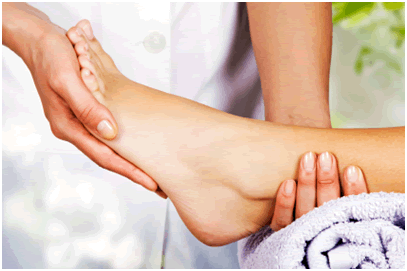 Morton's Neuroma occurs when a nerve between the third and fourth or the second and third toes becomes compressed or injured. Those with Morton's neuroma may typically feel sharp pain, burning, or numbness in the foot and the nerves may thicken causing a visible lump in the foot. According to Dr. Anthony Komaroff of Harvard Medical School, women are at a greater risk because they usually wear tight shoes or high heels. One of the best ways to prevent and treat Morton's neuroma is to wear low heeled shoes with a wider toe box so the bones, ligaments, muscles and nerves, are not squeezed. Dr. K also recommends massaging the area or visiting your foot care professional for metatarsal pads to help correct any structural problems you may have. If the pain persists, doctors may inject a local anesthetic with corticosteroid to reduce inflammation. Surgery may be needed if the previously mentioned methods do not work.
Morton's Neuroma occurs when a nerve between the third and fourth or the second and third toes becomes compressed or injured. Those with Morton's neuroma may typically feel sharp pain, burning, or numbness in the foot and the nerves may thicken causing a visible lump in the foot. According to Dr. Anthony Komaroff of Harvard Medical School, women are at a greater risk because they usually wear tight shoes or high heels. One of the best ways to prevent and treat Morton's neuroma is to wear low heeled shoes with a wider toe box so the bones, ligaments, muscles and nerves, are not squeezed. Dr. K also recommends massaging the area or visiting your foot care professional for metatarsal pads to help correct any structural problems you may have. If the pain persists, doctors may inject a local anesthetic with corticosteroid to reduce inflammation. Surgery may be needed if the previously mentioned methods do not work.
Morton's neuroma can be a difficult condition to live with. If you would like to learn more about your Morton's neuroma and possible treatment options, speak to Dr. Joshua David Scoll of Pennsylvania. Our doctor will diagnose and treat your feet accordingly.
Morton's Neuroma
Morton's neuroma is a painful foot condition that commonly affects the areas between the third and fourth toe and the ball of the foot, although other areas of the foot are also susceptible to this condition. Morton's neuroma is caused by an inflamed nerve in the foot that is being squeezed and aggravated by surrounding bones. Women are more likely than men to have an occurrence of this foot condition.
What Increases the Chances of having Morton's Neuroma?
-Ill-fitting high heels or shoes that add pressure to the toe or foot area.
-Jogging, running and any sports that involve constant impact to the foot area.
-Flat feet, bunions, and any other foot deformity may put you at a higher risk for developing Morton's neuroma.
If you suspect that you may have this condition, you should visit your podiatrist. A podiatrist will first conduct a thorough physical examination to check for palpable masses between the bones of the foot.
If you have any questions, please contact our offices located in Philadelphia and Bensalem, PA. We offer the newest diagnostic and treatment technologies for all your foot care needs.
Glamour Magazine Discusses Best Way to Avoid Blisters Altogether
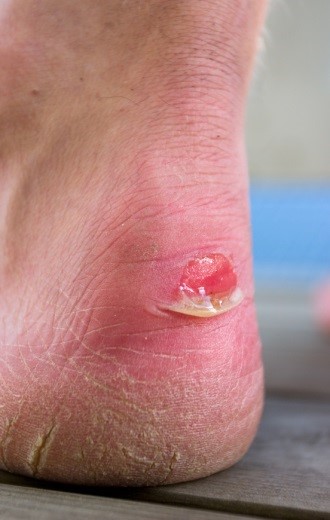 Glamour Magazine partnered with Australian Podiatrist, Dr. Phillip Vasyli, to discover the best way to avoid blisters on the feet while wearing new and stylish shoes. He initially stated that making sure the shoe fits properly and breaking them in before wearing them in public or at work are typically good starter points in avoiding blisters. “Checking your feet every day for signs of redness across the toes and heel is a key element in early detection and blister prevention,” stated Vasyli. Many women will see or feel a blister start to arise, ignore it, and will go through their day to find torn skin and potentially damaged shoes later. Vasyli wants readers to pay attention to their feet early on to avoid this. Some companies also make wax based anti-friction sticks to reduce the possibility of a blistery foot.
Glamour Magazine partnered with Australian Podiatrist, Dr. Phillip Vasyli, to discover the best way to avoid blisters on the feet while wearing new and stylish shoes. He initially stated that making sure the shoe fits properly and breaking them in before wearing them in public or at work are typically good starter points in avoiding blisters. “Checking your feet every day for signs of redness across the toes and heel is a key element in early detection and blister prevention,” stated Vasyli. Many women will see or feel a blister start to arise, ignore it, and will go through their day to find torn skin and potentially damaged shoes later. Vasyli wants readers to pay attention to their feet early on to avoid this. Some companies also make wax based anti-friction sticks to reduce the possibility of a blistery foot.
Blisters on the feet can be very uncomfortable and can cause plenty of problems if left untreated. If you sustained blisters on your feet, see podiatrist Dr. Joshua David Scoll of Pennsylvania. Dr. Scoll can treat your foot and ankle needs.
Blisters on the Feet
When tight or ill-fitting footwear is worn, many times a foot blister may develop. Blisters can even develop by constant rubbing from the shoe, often times leading to pain.
What is a Foot Blister?
A foot blister is a small pocket that is filled with fluid, forming on the upper most layer of the skin. Blisters are filled with clear fluid, and may lead to drainage of blood or pus if the area has become infected.
How do they Form?
Blisters of the feet are almost always the result of shoe rubbing and constant friction of the skin and material. Long periods of walking in shoes, sandals, or boots which don’t fit properly can result in a blister. Those who often have moisture or humidity in the feet are prone to blister formation easily.
For more information regarding the prevention and treatment of blisters on the feet, follow the link below.
If you have any questions feel free to contact one of our offices located in Philadelphia and Bensalem, NJ. We offer the latest in diagnostic and treatment technology to meet your needs.
Scientists of the University of Calgary Study Running Shoes
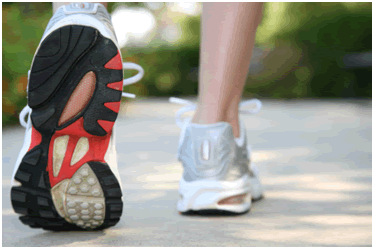 Faculty of Kinesiology within the University of Calgary have recently showed interest in building the perfect running shoe through studying the effects of comfort and its effect on the rates of injury. Even though the idea of the perfect running shoe has circulated for years, certain studies claim that shoe design has no effect on the rate in which running injuries occur.
Faculty of Kinesiology within the University of Calgary have recently showed interest in building the perfect running shoe through studying the effects of comfort and its effect on the rates of injury. Even though the idea of the perfect running shoe has circulated for years, certain studies claim that shoe design has no effect on the rate in which running injuries occur.
However, comfort has become a very big factor in the type of shoe runners will buy and many suggest that people should just go with the pair of running footwear that feels best for them. The scientific team still wants willing participants for their study, hoping to learn more through research.
For help with selecting an appropriate shoe size, consult with Dr. Joshua David Scoll of Pennsylvania. Dr. Scoll can measure your feet to determine what your needs are and help you find an appropriate pair of footwear.
Getting the Right Shoe Size
Sometimes it may be difficult finding the right shoe size especially because shoe sizes tend to vary depending on the brand and company you are looking for. A size 6 for one brand may be a size 7 in another. Although many people know their exact shoe size, it can range within 2 sizes depending on where they shop.
So it is important not to always go for a size 7 just because you think you might be a size 7 universally. It is best to try on the shoe and walk around for a bit to see how it fits and how it feels. Comfort is essential and the fitting has to be well otherwise it can lead to blisters, bruises at the back of the ankle and it can also hurt your toes if the shoe is too tight for example.
People walk a lot, so it is important for you to find what is comfortable when it is possible.
For more information about Getting the Right Shoe Size, follow the link below.
If you have any questions, please feel free to contact one of our offices located in Philadelphia and Bensalem, PA. We offer the newest diagnostic and treatment technologies for all your foot and ankle needs.
Read more about Choosing the Right Running Shoes
When Dealing with Plantar Fasciitis, Try Orthotics
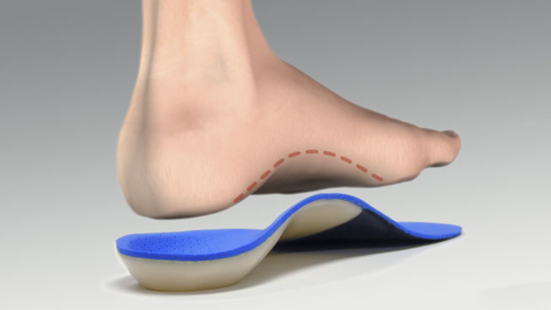 Plantar fasciitis is a painful condition that causes tendons in the feet to become inflamed. Foot orthotics are an effective way to mitigate the pain from this condition because it lowers the amount of pressure placed on one’s heel and diffuses the impact of one’s feet with the ground when walking.
Plantar fasciitis is a painful condition that causes tendons in the feet to become inflamed. Foot orthotics are an effective way to mitigate the pain from this condition because it lowers the amount of pressure placed on one’s heel and diffuses the impact of one’s feet with the ground when walking.
In addition, orthotics prevents irregularities in one’s biomechanics, which makes one less likely to get plantar fasciitis in the first place. Foot deformities and conditions can often be fixed through the use of custom orthotics, but it may be prudent to check with a medical professional before buying one.
Foot orthotics is useful for treating a myriad of conditions, including heel injuries like plantar fasciitis. If you are dealing with foot pain and are interested in the possibility of using orthotics as a treatment, call podiatrist Dr. Joshua David Scoll of Pennsylvania. Dr. Scoll can evaluate the severity of your condition and determine what type of care would best suit your needs.
What is Ankle Foot Orthotics?
Orthotics is physical aids used to support weak limbs or direct the proper function of limbs. Often they are used to support the ankle and foot. Such orthotics is known as AFOs. AFOs help strengthen the muscles or train them to function in the proper position. AFOs can also benefit muscles that need to be lengthened or loosened.
Why might you need orthotics?
Orthotics is often prescribed when someone is suffering from diseases that affect the musculature, like polio and multiple sclerosis. However, more common conditions like arthritis and stroke, or those that “toe in”, may also require orthotics.
Modern orthotics has improved dramatically from the metal braces of previous years. Many of today’s orthotics is made of lightweight plastics and other advanced materials to provide new levels of comfort and support. Often the orthosis is designed in a rigid L shape that is contoured to the calf and flesh colored.
For more information about Ankle Foot Orthotics, please follow the link below.
If you have any questions, please contact one of our offices located in Bensalem and Philadelphia, PA. We offer the newest diagnostic and treatment technologies for all your foot care needs.
Read more about Foot Ankle Orthotics
Thunder God Vine Can Aid Patients with Rheumatoid Arthritis
 A recent study published in the journal Annals of the Rheumatic Diseases recently found that a Chinese herb known as thunder god vine may be an effective treatment for Rheumatoid Arthritis. The study used 207 patients and observed their responses to the herb, the pharmaceutical drug methotrexate, and a combination of both.
A recent study published in the journal Annals of the Rheumatic Diseases recently found that a Chinese herb known as thunder god vine may be an effective treatment for Rheumatoid Arthritis. The study used 207 patients and observed their responses to the herb, the pharmaceutical drug methotrexate, and a combination of both.
After six months, the groups were assessed to see which achieved close to a fifty percent improvement in their pain and joint stiffness. Forty-six percent of the patients prescribed methotrexate noticed an improvement. This was lower than the fifty-five percent of participants given just the herb, and seventy-seven percent of those treated with both medications.
Characterized by stiffness and lack of mobility, Rheumatoid Arthritis is a painful condition that needs medical attention. For treatment options, see podiatrist Dr. Joshua David Scoll of Pennsylvania. Dr. Scoll can take care of any foot conditions and determine a treatment plan that is right for you.
What Is Rheumatoid Arthritis?
Rheumatoid Arthritis (RA) is an autoimmune disorder in which the body’s own immune system attacks the membranes surrounding the joints. Inflammation of the lining and eventually the destruction of the joint’s cartilage and bone occur, causing severe pain and immobility.
Rheumatoid Arthritis of the Feet
Although RA usually attacks multiple bones and joints throughout the entire body, almost 90 percent of cases result in pain in the foot or ankle area.
Symptoms
- Swelling & pain in the feet
- Stiffness in the feet
- Pain on the ball or sole of feet
- Joint shift and deformation
Diagnosis
Quick diagnosis of RA in the feet is important so that the podiatrist can treat the area effectively. Your doctor will ask you about your medical history, occupation, and lifestyle to determine the origin of the condition. Rheumatoid Factor tests help to determine if someone is affected by the disease.
For more information about rheumatoid arthritis please follow the link below.
If you have any questions, please contact our offices located in Philadelphia and Bensalem, PA. We offer the newest diagnostic and treatment technologies for all your foot and ankle injuries.
Read more on Rheumatoid Arthritis
Dealing with Ingrown Toenails
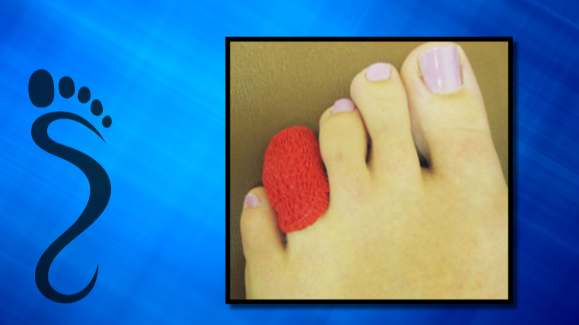 Margaret Abbott, a general practitioner (GP) at the Windmill Practice in Sneinton and the GP lead at NHS Nottingham City Clinical Commissioning Group, discusses methods to easing the pain of ingrown toenails. Ingrown toenails occur when the sides of the toenail grow into the surrounding skin, piercing the skin and causing it to become swollen and tender. Soaking the foot in warm water a couple of times a day should help clear the infection by loosening the skin and forcing the infection to grow out. Olive oil can be used to gently push the skin away while further softening the skin. Home remedies such as tea tree oil or a vapor rub can also be used, while an anti-inflammatory painkiller such as ibuprofen will ease the pain and reduce the inflammation.
Margaret Abbott, a general practitioner (GP) at the Windmill Practice in Sneinton and the GP lead at NHS Nottingham City Clinical Commissioning Group, discusses methods to easing the pain of ingrown toenails. Ingrown toenails occur when the sides of the toenail grow into the surrounding skin, piercing the skin and causing it to become swollen and tender. Soaking the foot in warm water a couple of times a day should help clear the infection by loosening the skin and forcing the infection to grow out. Olive oil can be used to gently push the skin away while further softening the skin. Home remedies such as tea tree oil or a vapor rub can also be used, while an anti-inflammatory painkiller such as ibuprofen will ease the pain and reduce the inflammation.
Ingrown toenails can become quite painful, especially if they are left untreated. If you are suffering from a painful ingrown toenail and are seeking treatment, consult with podiatrist Dr. Joshua David Scoll of Pennsylvania. Dr. Scoll will confirm your diagnosis and provide you with quality treatment.
Ingrown Toenails Causes
Ingrown toenails occur when a toenail grows sideways into the bed of the nail, causing pain, swelling, and possibly infection.
There are a number of risk factors for ingrown toenails. Some include cutting your nails too short, participating in strenuous sports, diabetes, obesity, and fungal infection. Some are genetically predisposed to ingrown nails, although wearing ill-fitting or damp shoes can exacerbate the problem.
Treatment
There are a number of steps you can take to treat ingrown nails:
-Let your toenails grow out
-Soak the toes in hot water with antibiotic soap or Epsom salts
-Placing a piece of cotton under the affected nail may allow the toe to grow up instead of into the nail bed
-Rest with your feet up
If however, your pain is severe, or you see red streaks running up your leg, you should see a podiatrist. Your podiatrist may make a small incision and remove part of the toe nail to relieve the pressure. A local anesthetic may be used to lessen the discomfort of the operation. Topical medication may also be prescribed to prevent the regrowth of the problem nail.
If you have any questions, please contact one of our offices located in Philadelphia and Bensalem, PA. We offer the newest diagnostic and treatment technologies for all your foot care needs.
Read more about Ingrown Toenails
Study Finds Shorter Nonsurgical Medical Treatment For Diabetics is More Effective
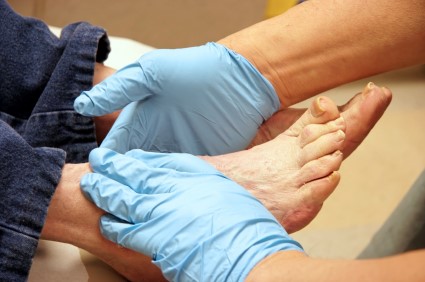 A study conducted by the Gustave Dron Hospital in France suggests that a shorter period of antibiotic treatment may be more effective in patients with diabetic foot osteomyelitis than other forms of treatment. The study was conducted using 40 patients that were given oral antibiotics for the disease between 2007 and 2009 from five French hospitals. According to the Infectious Diseases Society of America guidelines, diabetic foot osteomyelitis should be resolved within three months of antibiotic therapy. However, the study showed nearly two-thirds of the patients had achieved remission in about six to twelve weeks of treatment. This proves that a shorter time span of treatment and nonsurgical treatment are acceptable methods for certain patients with osteomyelitis.
A study conducted by the Gustave Dron Hospital in France suggests that a shorter period of antibiotic treatment may be more effective in patients with diabetic foot osteomyelitis than other forms of treatment. The study was conducted using 40 patients that were given oral antibiotics for the disease between 2007 and 2009 from five French hospitals. According to the Infectious Diseases Society of America guidelines, diabetic foot osteomyelitis should be resolved within three months of antibiotic therapy. However, the study showed nearly two-thirds of the patients had achieved remission in about six to twelve weeks of treatment. This proves that a shorter time span of treatment and nonsurgical treatment are acceptable methods for certain patients with osteomyelitis.
Diabetes is a very serious condition that can result in many complications if left untreated. If you are diabetic and have any concerns, visit Dr. Joshua David Scoll of Pennsylvania. Dr. Scoll can treat your diabetic feet.
Diabetic Foot Care
Diabetes affects millions of people of all ages each year. Diabetes damages blood vessels in many parts of the body, including the feet. When damage occurs to nerves in the feet, they may be unable to send the proper signals to the peripheral nervous system, resulting in a condition known as neuropathy. Once a diabetic patient develops neuropathy, it is imperative that the feet are well taken care of to avoid possible amputation of the feet.
The Importance of Caring for Your Feet
- Regularly check your feet for bruises or sores.
- Wear socks that fit your feet; socks shouldn’t be tight.
- Wear properly fitting shoes that are comfortable.
Patients with diabetes should have their doctor monitor their Hemoglobin A1C levels as this test lets the physician know how well the blood sugar levels have been controlled during the past 3 months. It is important to keep the blood sugar levels in a normal range (70-110mg/dl). It is advisable to visit a podiatrist if the diabetic patient is experiencing any conditions involving the feet.
For more information about Diabetic Foot Care, follow the link below.
If you have any questions feel free to contact one of our offices located in in Philadelphia and Bensalem, PA. We offer the latest in diagnostic and treatment technology to meet your needs.
Read more about Diabetic Foot Care
Shoe Clinic Donates New Shoes to Students of Linwood College
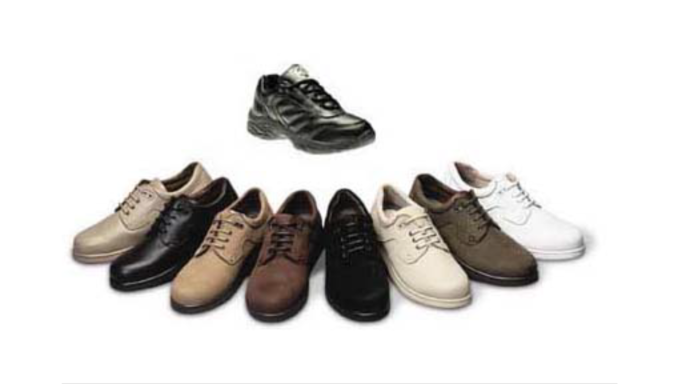 Students of all ages came to Linwood College in New Zealand to receive a new pair of correctly fitting shoes this month. Shoe Clinic in Riccarton has a 30-day return policy and typically donates those returns to schools and charities. In the past, many of these shipments have gone to the Salvation Army and certain disaster zones, but Linwood College is currently the latest to receive the next large shipment of donations. Although finding the perfect shoe for each student was relatively difficult, everyone was eventually fitted by a professional with a new sneaker. Many students even stated that they were thankful for the shoes since they were involved in many sports, but did not have the proper footwear for them.
Students of all ages came to Linwood College in New Zealand to receive a new pair of correctly fitting shoes this month. Shoe Clinic in Riccarton has a 30-day return policy and typically donates those returns to schools and charities. In the past, many of these shipments have gone to the Salvation Army and certain disaster zones, but Linwood College is currently the latest to receive the next large shipment of donations. Although finding the perfect shoe for each student was relatively difficult, everyone was eventually fitted by a professional with a new sneaker. Many students even stated that they were thankful for the shoes since they were involved in many sports, but did not have the proper footwear for them.
To ensure that their feet will grow and develop healthily, children need to proper fitting shoes on their feet. For more information about determining proper shoe fitting for children, see Dr. Joshua Scoll of Pennsylvania. Dr. Scoll will treat your foot and ankle needs.
Proper Shoe Fitting
A common concern when it comes to foot health, having properly fitted shoes can help prevent injuries to the foot. Out feet affect our posture and gait, which in turn affects the biomechanics and overall bodily structure. With 33 joints, 26 bones, and over 100 ligaments, the potential for serious injury is much greater than one realizes. Although the feet cease growth in adulthood, they still change shape as they mature. Here are some factors to consider when it comes to investing in properly fitting shoes:
- Be sure the shoes fit correctly right away
- Ensure the ball of your foot fits comfortably in the widest portion of the shoes
- Even though they may look fashionable, improperly fitting shoes can either create adverse conditions or exacerbate existing ones you may already have
- Walk along a carpeted surface to ensure the shoes comfortably fit during normal activity
For more information about Proper Shoe Fitting, follow the link below.
If you have any questions, please contact one of our offices located in Philadelphia and Bensalem, PA. We offer the newest diagnostic and treatment technologies for all your foot care needs.
Read more about Proper Shoe Fitting
Everyday Foot Care in the Winter
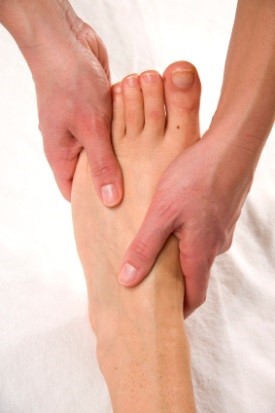 Winter is a season in which the feet are often neglected, as the feet are usually kept wrapped up in shoes. This makes winter foot care especially important. Keeping the feet healthy during the colder months is easy, however, with a few simple tips. Moisturizing the feet is one of the most important measures one can take to keep the feet looking fresh and healthy. Wearing thick shoes and thick socks during the winter is important to keep them protected from harsh temperatures, and can go a long way towards foot health. Pedicures and hot water treatments can help relax tense and weathered feet, while drinking plenty of water will help keep the skin hydrated.
Winter is a season in which the feet are often neglected, as the feet are usually kept wrapped up in shoes. This makes winter foot care especially important. Keeping the feet healthy during the colder months is easy, however, with a few simple tips. Moisturizing the feet is one of the most important measures one can take to keep the feet looking fresh and healthy. Wearing thick shoes and thick socks during the winter is important to keep them protected from harsh temperatures, and can go a long way towards foot health. Pedicures and hot water treatments can help relax tense and weathered feet, while drinking plenty of water will help keep the skin hydrated.
Regardless of season or weather, everyday foot care should be practiced year round. For more information about everyday foot care, consult with podiatrist Dr. Joshua Scoll. Dr. Scoll will provide you with the foot- and ankle information you seek.
Every Day Foot Care
Often, people take care of their bodies, face and hair more so than they do for their feet. But the feet are a very important aspect of our bodies, and one that we should pay more attention to. After all, without our feet, we would not be able to perform most daily tasks. It is best to check your feet regularly to make sure there are no new bruises or cuts that you may not have noticed before, for example.
For dry feet, moisturizer can easily be a remedy and can be applied as often as necessary to the affected areas. Wearing shoes that fit well can also help you maintain good foot health, as well as making it easier to walk and do daily activities without the stress or pain of ill-fitting shoes, high heels, or even flip flops.
Also, wearing clean socks with closed shoes is important to ensure that sweat and bacteria do not accumulate within the shoe. Clean socks help to prevent athlete’s foot, fungi problems, bad odors, and can absorb sweat.
If you have any questions, please feel free to contact our office located in Philadelphia and Bensalem, PA. We offer the newest diagnostic and treatment technologies for all your foot and ankle needs.
Read more about Everyday Foot Care
President Obama Struggles with Effects of Plantar Fasciitis
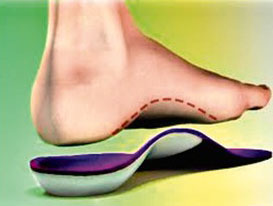 As leader of the United States of America, President Barack Obama needs to be on his feet with all the meetings and conferences he must attend daily. As a result, it may come to no surprise that our president has been contending with pain in his right foot. Dr. Ronny L. Jackson states that Obama’s symptoms happen to be consistent with “regular recurring plantar fasciitis”.
As leader of the United States of America, President Barack Obama needs to be on his feet with all the meetings and conferences he must attend daily. As a result, it may come to no surprise that our president has been contending with pain in his right foot. Dr. Ronny L. Jackson states that Obama’s symptoms happen to be consistent with “regular recurring plantar fasciitis”.
Chronic plantar fasciitis tends to be common among middle aged people, especially those with overworked feet. Fortunately, our president remains up to the task and is said not to be hampered by his foot pain.
Plantar fasciitis can be quite painful. If you have heel pain, visit Dr. Joshua Scoll. Dr. Scoll can treat your heel pain as well as any other foot or ankle condition.
What is Plantar Fasciitis?
Plantar fasciitis refers to heel and arch pain caused by an inflammation of the connective tissues on the bottom of the foot.
What Causes Plantar Fasciitis?
- Ill-fitting shoes
- Weight change
- Excessive running
- Non-supportive shoes
- Overpronation
How Can It Be Treated?
- Conservative measures – anti-inflammatories, ice packs, stretching exercises, physical therapy, orthotic devices.
- Shockwave therapy – sends sound waves to the areas where pain is experience. Requires multiple sessions. This is used for very persistent cases of plantar fasciitis.
- Ultrasound-guided technique with steroid injections into the plantar fascia. This is from a relatively new and small study, but was shown to be effective in most cases treated.
New Studies on Treatment
According to groundbreaking treatment option studies, Luca M. Sconfienza, M.D. says that ultrasound with steroid injections was effective in over 95% of cases that involve plantar fasciitis. This process involves anesthesia and is a single process, out-patient treatment that was discovered to be highly effective. Luca M. Sconfienza M.D. presented her study at an annual meeting for the Radiological Society of North America (RSNA). Be sure to speak with your podiatrist about different methods that can be used, as well as finding out what treatment options they offer.
If you have any questions, please feel free to contact our office located in Philadelphia and Bensalem, PA. We offer the newest diagnostic and treatment technologies for all your foot care needs.
Read more about Plantar Fasciitis
